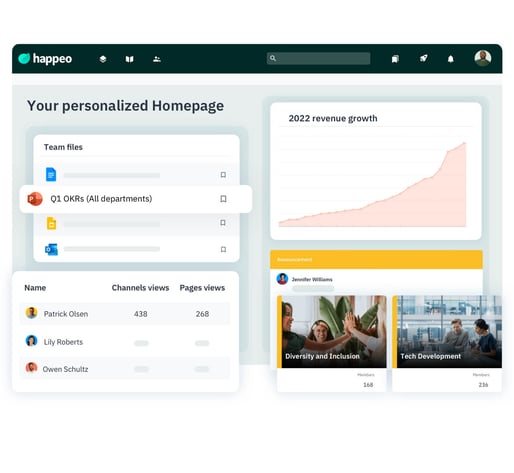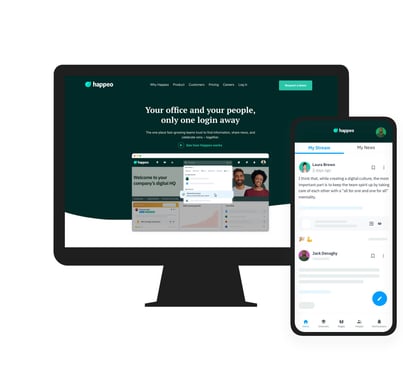
Internal Communications Comparisons
Intranet portals: Get organized and engage your employees

7 mins read
Start building your digital home with Happeo
Request a demoInternal Communications Comparisons
Product
Features
Solutions
Happeo for
Use cases
Resources
Explore
Support
Happeo For
Use cases
Comparisons
Explore
Support
Recent

Jonathan Davies
7 mins read
Disorganization is a problem in many workplaces. A survey of 1,000 knowledge workers found that a quarter of respondents spent more than two hours a day searching for information they needed to do their jobs.
The survey also revealed that many workers lost time due to switching between platforms, repeated interruptions, and inadvertently duplicating tasks.
So, how do you organize information, improve day-to-day processes, and alleviate common frustrations for employees? It’s easier than it sounds, when you invest in an intranet portal.
In this post, we’ll explain the key functions of an intranet portal, how it benefits employees, and what to look for when you’re shopping for a solution.
An intranet portal is a digital platform that facilitates communication, knowledge sharing, and file management. When it integrates with other platforms businesses are already using — such as project management software or CRM systems — employees can access information from those systems within the intranet portal.
An intranet portal helps employees feel connected and makes it easier for them to find the resources they need. An employee intranet portal can:
Improve knowledge management
An intranet serves as a central repository for all files, so employees know exactly where to find documents and assets.
Personalize employee experiences
Legacy intranet systems offered little in the way of personalization, but modern social intranet platforms let employees customize their timelines to see only the information that’s most relevant to them.

Improve Internal Communications
An intranet portal improves all aspects of internal communications — from top-down messaging to team brainstorming.
Enable a user-generated knowledge base
With an intranet portal, employees can share knowledge across teams, providing greater transparency into everyone’s roles.
Streamline employee onboarding
Intranet portals help new hires quickly acclimate to their roles. All of the information they need is contained within one centralized platform, so there’s less risk of new hires feeling “lost” or overwhelmed.
Promote team collaboration
An intranet portal includes several features that promote team collaboration, such as shared calendars for scheduling meetings, video call support, and direct messaging.
Integrate with existing workspaces
Platforms that integrate with Google Workspace and Microsoft365 help employees find documents quickly, without needing to leave the intranet portal.
Obviously, an intranet platform offers many benefits. But each platform has different features. (For example, Happeo integrates with both Google Workspace and Microsoft365, whereas SharePoint lacks a Google Workspace integration).
As you look for an intranet portal for your business, keep an eye out for the following features:
Knowledge sharing — or document sharing — is one of the most essential features in an intranet portal. However, if the platform doesn’t integrate with your existing workspaces, employees might have to leave the portal to find files, which has a negative impact on productivity.
Look for an intranet portal that integrates with your other production environments and essential business software.
An employee directory is a useful feature, and even more so if it helps employees match names with faces. At a time when many employees are working remotely, a robust employee directory with “people pages” — digital cards that include an employee’s photo, title, department, groups, and contact info — can help foster connection.
Integration with other platforms is beneficial, but an intranet platform should also include a universal search feature that lets employees find files that might be outside of the portal. Look for a search function that fulfills this need and also searches across calendars, user profiles, and social intranet posts.
Happeo’s Federated Search feature also enables users to find content from third-party platforms in the same search bar. This prevents employees from having to click between disparate systems looking for information.
It’s no secret that companies are increasingly struggling to retain talent, especially when remote work opportunities are abundant. An intranet portal with social components could help engage employees and improve morale, which in turn could reduce turnover.
Look for an intranet platform that lets employees share, like, and comment on each other’s posts. Workers still need “water-cooler conversations,” even if they’re virtual.
Intranet portals that include content lifecycle management features ensure that employees aren’t working with outdated content. This functionality is especially useful for HR teams that need to update and sunset policies on a regular basis.
An intranet portal functions as an internal CMS, so look at whether administrators can easily format and publish content without the need for development or design skills.
Ideally, you’ll want a platform that includes templates for intranet pages, a customizable login page, and optional upgrades for a completely branded experience.
An intranet portal with a mobile app helps employees stay connected, even when they’re away from their desks. App users can configure their push notifications and ensure they never miss out on important announcements or urgent requests.

An intranet portal is an investment, so you want to be sure employees are actually using it. Built-in usage Analytics can help you see whether employees are engaging with the platform, what types of content they’re most interested in, and who your top “thought leaders” are.
When you’re exchanging confidential information within your intranet portal, you’ll need to be sure it’s protected from unauthorized access. Look for a platform with ISO 27001 certification, SAML, and single sign-on capabilities.
By now, you may be thinking, “An intranet portal sounds great — but how long will it take to implement?” Good question!
Some intranet portals can take upwards of a year to launch, but 54% of Happeo’s customers launch within 90 days, and 87% launch within six months. That’s because Happeo recommends a specific onboarding package based on the size of a customer’s business, then we ask a select group of your stakeholders to begin using the platform before the full rollout.
During and after onboarding, you can count on Happeo’s dedicated support team to answer your questions, show you how to use features, and check in with you regularly to make sure you’re getting the best return on your investment.
If you’re ready to get organized, work more efficiently, and engage your employees, it’s time you tried Happeo. Take a closer look at what Happeo can do. And when you’re ready, schedule your free demo!
